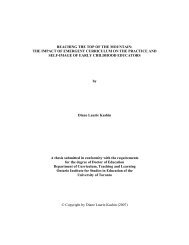Beyond the button
Create successful ePaper yourself
Turn your PDF publications into a flip-book with our unique Google optimized e-Paper software.
<strong>Beyond</strong> <strong>the</strong> Button<br />
From <strong>the</strong><br />
Pedagogical Documentation Exhibit facilitated by Diane Kashin, RECE<br />
April 23, 2016, Algonquin College Perth Campus hosted by Raising <strong>the</strong><br />
Bar and <strong>the</strong> Lanark Early Learning and Child Care Association<br />
Assembled by Kathy Boelsma, Early Literacy Specialist Lanark County
Making our thinking visible<br />
This documentation was created and shared with early years educators<br />
on a Saturday in April, 2016.<br />
It took courage to “go public”.<br />
Thank you to Dr. Diane Kashin for leading us through this experience.<br />
Please view this ebook with <strong>the</strong> idea of appreciating <strong>the</strong> many<br />
perspectives presented, <strong>the</strong> visual literacy skills and <strong>the</strong> eagerness to<br />
learn and apply our learning. Examine, reflect and talk to someone<br />
about what you think about some of <strong>the</strong>se ideas.
The Learning Story<br />
An example of a Learning Story by Tom<br />
Drummond
Writing a Learning Story<br />
Writing a Learning Story by Pat Holborn
Learning Stories: The<br />
Power of Narrative<br />
Inquiry<br />
by Diane Kashin, RECE<br />
https://tecribresearch.wordpress.c<br />
om/2016/03/19/learning-stories<strong>the</strong>-power-of-narrative-inquiry/
• Quotes from <strong>the</strong> previous blog posting:<br />
• “Even though it appears that learning stories are more about one child, <strong>the</strong>y can be used to capture<br />
<strong>the</strong> learning of a group. It is a means to engage in research. It is narrative inquiry. “<br />
• “Narrative inquiry is <strong>the</strong> process of ga<strong>the</strong>ring information for <strong>the</strong> purpose of research through<br />
storytelling.<br />
• Narrative inquiry focuses on meaning making. “<br />
• According to Connelly and Clandinin (1990), “humans are storytelling organisms who, individually<br />
and socially, lead storied lives. The study of narrative <strong>the</strong>refore is <strong>the</strong> study of <strong>the</strong> ways humans<br />
experience <strong>the</strong> world. This general notion translates into <strong>the</strong> view that education is <strong>the</strong><br />
construction and reconstruction of personal and social stories; teachers and learners are<br />
storytellers, characters in <strong>the</strong>ir own and o<strong>the</strong>r’s stories” (p. 2).<br />
• To make meaning requires <strong>the</strong> researcher to seek multiple perspectives to give <strong>the</strong> story shape and<br />
dimension. The perspective of <strong>the</strong> teacher as researcher is part of <strong>the</strong> story. Learning stories<br />
provide a platform to hear <strong>the</strong> voice of <strong>the</strong> teacher. There is an opportunity to go beyond<br />
identifying a skill or indicator from a developmental continuum.<br />
• What is required is “active, engaged early childhood educators who are not external, passive<br />
observers of children and objective producers of knowledge about children” (Pacini-Ketchabaw,<br />
Nxumalo, Kocher, Elliot & Sanchez, 2014, p. 15).
Thank you for learning toge<strong>the</strong>r.

















